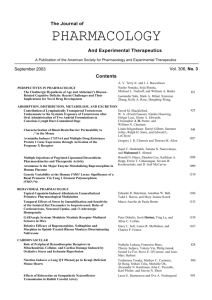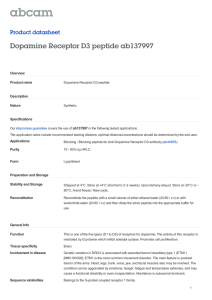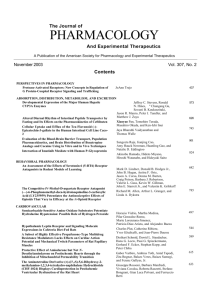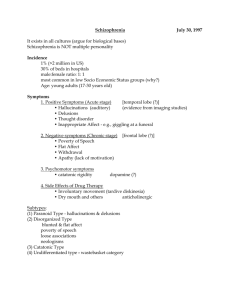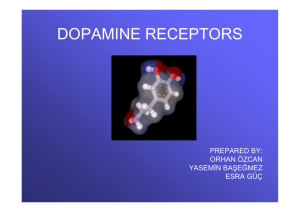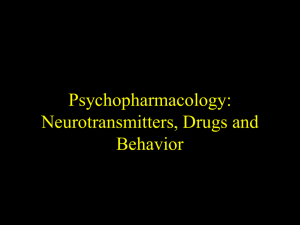British Journal of Pharmacology and Toxicology 2(6): 310-317, 2011 ISSN: 2044-2467
advertisement
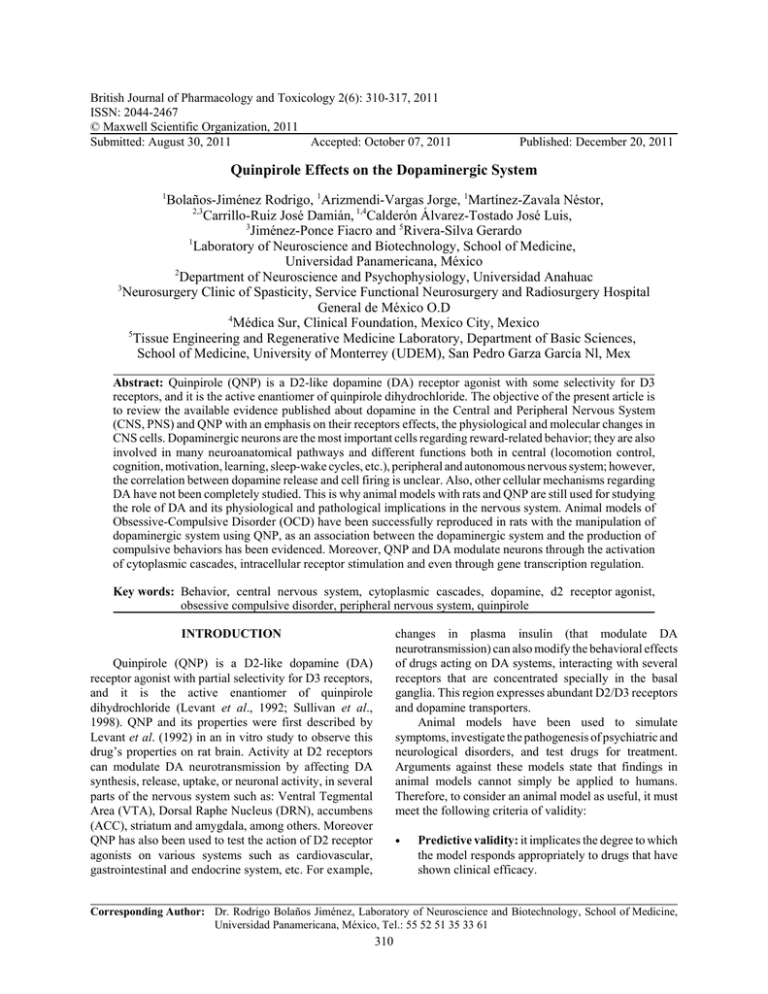
British Journal of Pharmacology and Toxicology 2(6): 310-317, 2011 ISSN: 2044-2467 © Maxwell Scientific Organization, 2011 Submitted: August 30, 2011 Accepted: October 07, 2011 Published: December 20, 2011 Quinpirole Effects on the Dopaminergic System 1 Bolaños-Jiménez Rodrigo, 1Arizmendi-Vargas Jorge, 1Martínez-Zavala Néstor, 2,3 Carrillo-Ruiz José Damián, 1,4Calderón Álvarez-Tostado José Luis, 3 Jiménez-Ponce Fiacro and 5Rivera-Silva Gerardo 1 Laboratory of Neuroscience and Biotechnology, School of Medicine, Universidad Panamericana, México 2 Department of Neuroscience and Psychophysiology, Universidad Anahuac 3 Neurosurgery Clinic of Spasticity, Service Functional Neurosurgery and Radiosurgery Hospital General de México O.D 4 Médica Sur, Clinical Foundation, Mexico City, Mexico 5 Tissue Engineering and Regenerative Medicine Laboratory, Department of Basic Sciences, School of Medicine, University of Monterrey (UDEM), San Pedro Garza García Nl, Mex Abstract: Quinpirole (QNP) is a D2-like dopamine (DA) receptor agonist with some selectivity for D3 receptors, and it is the active enantiomer of quinpirole dihydrochloride. The objective of the present article is to review the available evidence published about dopamine in the Central and Peripheral Nervous System (CNS, PNS) and QNP with an emphasis on their receptors effects, the physiological and molecular changes in CNS cells. Dopaminergic neurons are the most important cells regarding reward-related behavior; they are also involved in many neuroanatomical pathways and different functions both in central (locomotion control, cognition, motivation, learning, sleep-wake cycles, etc.), peripheral and autonomous nervous system; however, the correlation between dopamine release and cell firing is unclear. Also, other cellular mechanisms regarding DA have not been completely studied. This is why animal models with rats and QNP are still used for studying the role of DA and its physiological and pathological implications in the nervous system. Animal models of Obsessive-Compulsive Disorder (OCD) have been successfully reproduced in rats with the manipulation of dopaminergic system using QNP, as an association between the dopaminergic system and the production of compulsive behaviors has been evidenced. Moreover, QNP and DA modulate neurons through the activation of cytoplasmic cascades, intracellular receptor stimulation and even through gene transcription regulation. Key words: Behavior, central nervous system, cytoplasmic cascades, dopamine, d2 receptor agonist, obsessive compulsive disorder, peripheral nervous system, quinpirole changes in plasma insulin (that modulate DA neurotransmission) can also modify the behavioral effects of drugs acting on DA systems, interacting with several receptors that are concentrated specially in the basal ganglia. This region expresses abundant D2/D3 receptors and dopamine transporters. Animal models have been used to simulate symptoms, investigate the pathogenesis of psychiatric and neurological disorders, and test drugs for treatment. Arguments against these models state that findings in animal models cannot simply be applied to humans. Therefore, to consider an animal model as useful, it must meet the following criteria of validity: INTRODUCTION Quinpirole (QNP) is a D2-like dopamine (DA) receptor agonist with partial selectivity for D3 receptors, and it is the active enantiomer of quinpirole dihydrochloride (Levant et al., 1992; Sullivan et al., 1998). QNP and its properties were first described by Levant et al. (1992) in an in vitro study to observe this drug’s properties on rat brain. Activity at D2 receptors can modulate DA neurotransmission by affecting DA synthesis, release, uptake, or neuronal activity, in several parts of the nervous system such as: Ventral Tegmental Area (VTA), Dorsal Raphe Nucleus (DRN), accumbens (ACC), striatum and amygdala, among others. Moreover QNP has also been used to test the action of D2 receptor agonists on various systems such as cardiovascular, gastrointestinal and endocrine system, etc. For example, C Predictive validity: it implicates the degree to which the model responds appropriately to drugs that have shown clinical efficacy. Corresponding Author: Dr. Rodrigo Bolaños Jiménez, Laboratory of Neuroscience and Biotechnology, School of Medicine, Universidad Panamericana, México, Tel.: 55 52 51 35 33 61 310 Br. J. Pharmacol. Toxicol., 2(6): 310-317, 2011 C C Face validity: it refers to the phenomenological similarity between the model and the disorder it seeks to imitate. A valid animal model should show similarity between the most characteristic symptoms of a pathological condition. Construct validity: Refers to the theoretical reasoning behind the model (Mc-Kinney et al., 1969). behavior, among other functions. The neurons in this location are involved with the mesocorticolimbic system, so they have to do with Gamma-aminobutyric acid (GABA) and DA, although it has been demonstrated that there are wide-spike non-dopaminergic, non-GABAergic neurons susceptible to inhibition by QNP (Luo et al., 2008). In the dorsal raphe nucleus (DRN) of brainstem, there is a moderate concentration of D2 receptors (Yokoyama et al., 1994), and their activation by QNP in this area can modify the response of the striatum to psychomotor stimulants. It has been seen that this has to do with modifications in serotonin transmission; even so, the receptors’ role in the DRN is unclear (Ferré et al., 1994). There is also evidence of QNP’s effects in neurotransmission in other regions of the brain. In the prefrontal cortex, it reduces the basal release of acetylcholine (ACh). In the accumbens nucleus, there are glutamatergic modifications due to these changes in ACh that modulate NMDA receptors and due to postsynaptic connections (Tecuapetla et al., 2010). This could be related to the mechanism of focusing in the attention process (Brooks et al., 2007). However, a useful animal model does not necessarily have to reproduce all the clinical manifestations of human disease; in fact, studying the differences can be as important as studying the similarities. So, different animal models may be more appropriate to work on for researching specific disease mechanisms and therapeutic modes. CELLULAR PHYSIOLOGY Dopamine is a catecholamine that serves as a neurotransmitter. It is involved in various functions throughout the CNS: sleep-wake cycles, prolactine regulation, locomotion control, motivation, mood, cognition, learning, pleasure, reward, etc. Its actions are mediated by the subtype of receptor it binds to. There are five different receptor subtypes (D1, D2, D3, D4, D5), which are divided into two major subclasses: the D1-like and D2-like receptors. DA receptors belong to the category of G-protein-coupled receptors, specifically to Gs and Gi (Jaber et al., 1996). Activation of dopaminergic neurons may lead to different effects, depending on the nervous structure DA is released, for example, activation of D2-like receptors suppresses the light-sensitive cAMP pool and inhibits melatonin synthesis in photoreceptor cells (Patel et al., 2003), in the hippocampus and striatum, activation of this type of receptors in normal rats induces inhibition of excitatory transmission regulated by glutamate in the CA1 synapses (Huang and Kandel, 1995), most probably by activating K+-channels, leading to cell hyperpolarization (Jackson and Westlind-Danielsson, 1994; Bunzow et al., 1988). Also, activation of D2-like receptors has an excitatory effect on locomotion (Koeltzow et al., 2003), depolarizes GABAergic interneurons in a direct way and contributes to the processing of the visual signaling in the Dorsolateral Geniculate Nucleus (DLGN) of thalamus (Munsch et al., 2005). Dopamine actions on different central nervous system locations: It has been evidenced that DA is involved in the following anatomical circuits where it carries out its effects; cortex-striatum-globus pallidus, substantia nigrathalamus-cortex and the cortex-striatum-globus pallidussubthalamic nucleus-globus pallidus-substantia nigrathalamus-cortex circuit (Lindsey and Gatley, 2006; Kirkby, 1969; Kolb, 1977). The stimulatory effect of DA in these circuits facilitates thalamo-cortical activation. However, activation of D2 receptors in striatopallidal neurons inhibits these proyections, leading to a decreased motor activity (Gerfen, 1992). The connections between these structures are important, as they are the basis for performing functions such as movement and thought (Jackson and Westlind-Danielsson, 1994; Bunzow et al., 1988). There are other ways in which DA is involved in the relationship between thalamus and cortex and with other neurotransmitters. Presynaptic D2-like receptor activation has been seen in thalamic neurons in the DLGN with projections to the cortex, as well as in thalamic interneurons. The activation of these receptors by D2 agonists, such as QNP, causes the inhibition of GABA release mediated by Ca2+ from the reticular thalamic nucleus (Florán et al., 2004). In the DLGN, the GABAergic interneurons do synapses through axonal terminals, which are, in fact, dopaminergic, and through dendritic sites (Papadopoulos and Parnavelas, 1990). The striatum is another nervous structure with dopaminergic action. Its importance lies in being a major postsynaptic target of dopaminergic projections in mammalian brain (Seeman, 1980). It has been identified Neurotransmitters: Dopamine, as abundant as it is in the nervous system, it interacts with many other neurotransmitters. Therefore, the relation between QNP and other neurotransmitter systems has some implications. Activity at D2-like receptors can modulate DA neurotransmission by affecting DA synthesis, release, uptake, or neuronal activity. The Ventral Tegmental Area (VTA) in the midbrain is an area that has to do with motivation, recompense and 311 Br. J. Pharmacol. Toxicol., 2(6): 310-317, 2011 D2-like receptors in the rest of the gastro-intestinal tract were not taken on account, so it would be interesting to assess the effects of QNP in other organs besides the stomach to completely understand the role of DA in the gastrointestinal system. Interestingly, insulin also has to do with DA physiology. Rats with a decreased level of circulating insulin show less coupling of D2 receptors to Gi/0 proteins and reduced DA transporters activity. Rats with hypoinsulinemia induced by streptozotocin show decreased synthesis, uptake, and turnover of DA in the striatum (Sevak et al., 2007). D2-like receptors with inhibitory and excitatory responses on it (Skirboll et al., 1979; Bradshaw et al., 1985). Activation of these receptors causes a modification in cell permeability to K+ as it has been stated (Freedman and Weight, 1988). D2 receptors, as well as D1 and D3, are expressed in neurons in other areas of the brain, such as the neostriatum, substantia nigra and pallidum. These receptors also cause modifications in the ion permeability of the cells, as they produce changes in Na+ currents and cell excitability (Surmeier et al., 1992). Another effect of DA receptors is the suppression of Na+/K+ ATPase activity in neostriatal neurons by a synergistic action of D1 and D2 agonists (Bertorello et al., 1990). Quinpirole-dopamine and behavior: It has been reported that chronic administration of QNP causes repetitive behaviors in laboratory animals, as deficits in task performance, impairing accuracy, increasing omissions, decreasing in the number of trials completed has been noted, once the animal is taught to behave in a certain way in a specific situation (Einat and Szechtman, 1995; Winstanley et al., 2010). Repeated administration of DA D2 agonist produces receptor supersensitivity, in a process known as receptor priming. This is the responsible mechanism of some acutely enhanced behaviors following treatment with a DA agonist such as QNP. Receptor supersensitization is known to occur in psychiatric disorders including schizophrenia, Obsessive Compulsive Disorder (OCD) and motor dyskinesias associated with neurological disorders, and it explains some of their clinical manifestations. In sensitized animals, QNP produces alterations in stereotypes, antinociception, locomotor activity, learning, memory, and it also produces strange vertical jumping in rats (Kostrzewa et al., 2004). Paradoxically, Yokoyama and cols. state that high dose of selective D2-receptor antagonist potentiates locomotor excitation induced by QNP. However, it produces a decrease in locomotor activity in the first quarter of an hour, and induces locomotor excitation in the second hour of administration (Yokoyama et al., 1994). Today, it is known that D3 receptors have higher affinity for QNP, compared to D2 (Sokoloff et al., 1990). Low doses of QNP can induce increased oral behavior, and yawning behavior in male rats, that is why it has been postulated that D3 receptor is responsible for causing dopaminergic agonism and for inducing yawning behavior (Kostrzewa and Brus, 1991; Brus et al., 1996). Moreover, QNP has also an impact on fear behaviors decreasing them. This may be the result of the effect in presynaptic D2 auto-receptors in the VTA, decreasing DA levels in the mesocorticolimbic tract. This further supports the classical conditioning theory that this neural circuit is involved in the expression and acquisition of conditioned fear (De-Oliveira et al., 2009). QNP and DA in peripheral and autonomous nervous system: QNP causes other physiological effects on peripheral DA receptors. On cardiovascular system, its effect on blood pressure is due to central pressor, peripheral sympathetic depressor and spinal depressor effects (Lahlou, 1998). These are achieved by the following mechanisms: there is a central activation of sympathetic outflow, mediated by D2 receptors, which is associated with vasopressin release (Nagahama et al., 1986). Also, in rabbits it has been evidenced that QNP increases blood pressure by causing a DA release from the tractus solitarius nucleus of medulla (Yang et al 1990). This increasing in DA concentrations activates chemoreceptor mechanisms that cause a pressor response, which are similar to those seen during hypoxia (Van den Buuse et al., 1998). Moreover, previous studies in rats have shown that intrathecal DA agonists stimulate spinal DA receptors, which cause a withdrawal of spinal sympathetic outflow to the heart and vasculature, resulting in a decrease in mean aortic pressure and heart rate (Lahlou and Demenge, 1993). On a study in which the role of specific DA receptor subtypes was tested, it was proved that selective D2 agonists produced dosedependent decreases in hindquarter vascular resistance, mean arterial pressure and heart rate. Changes in cardiac contractility were also looked for, but none of the tests produced significant changes (Polakowski et al., 2004). It has been evidenced that DA is involved in lumbar locomotor network in rats (Barrière et al., 2004). Application of DA induces slow locomotor-like rhythmic activity in ventral motor roots. QNP tests have also been done, but it seems to have no effect. Also, DA is an important regulator of gastric function in the brain-gut axis, and it has an inhibitory effect on the gastric acid secretion. It has also been suggested that DA D1, D2 and D5 receptor proteins are present in the gastrointestinal tract from the stomach through to the distal colon. In a protocol, it was seen that QNP had an inhibitory effect on gastric acid secretion regulated by histaminergic, pentagastrin and cholinergic stimulus (Eliassi et al., 2008). However, the effects of peripheral 312 Br. J. Pharmacol. Toxicol., 2(6): 310-317, 2011 OCD, bipolar disorder and long-term addiction to psychostimulants. It is believed that the cognitive deficits are consequence of the hippocampal ACh system suppression (Brown et al., 2004). The role of DA in the function of the internal clock has been acknowledged in other studies; DA agonist causes an overestimation of time and DA antagonist causes an underestimation of time (Harper et al., 2006). Another Psychiatric condition where the role of DA is accredited is psychogenic polydipsia, this model is done by repeated administration of amphetamine-like compounds or by the QNP. The inhibition of D2 receptors modulates the excessive drinking of the rats in the model (Amato et al., 2008). Animal models of psychiatric disorders: The role of DA in the pathogenesis of several psychiatric disorders has been widely discussed and investigated. This is due to the importance of DA on the pathophysiology of these illnesses and as a potential target of pharmacological treatment. The dysfunction in the control of neurotransmission of DA in the limbic system results in abnormal states that characterize several psychiatric and neurological disorders (Benaliouad et al., 2009). OCD is a well-known psychiatric condition characterized by recurrent thoughts (obsessions) and ritual acts (compulsions). In the pathophysiology of this disorder, both dopaminergic and serotoninergic systems have been implicated. (Tizabi et al., 2002). It has been stated that compulsions arise as negative reinforces because they reduce the anxiety caused by obsessive thoughts (Tykocinski and Pittman, 1998). The dopaminergic pathways that ascend through the mesolimbic pathway are the source of the OCD reinforcements in the CNS (McGuire et al., 1994). With this basis, it has been created with success an animal model in rats by manipulating with QNP the dopaminergic system; this model meets formal checking criteria of OCD (Szechtman and Eilam, 1998; Szechtman et al., 2001) and produces behaviors that replicate motorlike persistent compulsions (Eilam et al., 1989). QNP use in different animal models has been stated in other studies and in them, perseverance has been observed with the chronic application of the drug (Szechtman and Eilam, 1998; Kurylo and Tanguay, 2003; Kurylo, 2004). The perseverance affects some cognitive functions in the animal models such as reversal learning, where subjects have to inhibit a previously learned response and emit responses originally not reinforced, and contrafreeloading (CFL) where animals continue to respond for a reward in an operant setting even after the same reward becomes available at no cost. Both normal functions become affected by increasing the number of trials and incorrect responses in the reversal learning phase and by increasing the CFL rate (Boulougouris et al., 2009; Milella et al., 2008). The treatment of choice in human patients with OCD is clomipramine, a tricyclic antidepressant with potent effect on serotonin reuptake, if administrated to the animal model, the QNP-induced checking behavior in rats becomes partially attenuated; this supports the validity of the OCD animal model (Stein et al., 2009; Lambert, 2008). Otherwise conditioned reinforcement has been involved in the development or maintenance of goal-directed behaviors associated with drug addictions (Collins and Woods, 2009). Another interesting finding in which DA is implicated is cognitive impairment, as a result from long term increase in the dopaminergic activity. This abnormal increase in the dopaminergic activity can be found in a number of mental disorders including schizophrenia, CELLULAR AND MOLECULAR BIOLOGY Besides the visible manifestations of QNP and DA in various physiological aspects of the nervous system, they also produce their effects mediating and modulating nervous cells via activation of cytoplasmic cascades, intracellular receptors and even modulating transcription. As we have previously stated, part of the nervous physiology is regulated by DA and the effects its receptors, mainly D1 and D2, produce both individually and synergistically. Possible mechanisms include changes in cell excitability by modulation of ion channel activity (Hernández-López et al., 1997) in the short term. This is possible due to a reduced production of cAMP by effect of D2 receptors, but cell excitability may also be changed by an elevation of intracellular calcium (Nishi et al., 1997). But also, long-term changes can be achieved by regulation of gene expression, having durable modifications in synaptic plasticity (Gerfen et al., 1990). There are two important molecules involved in this mode, both related to D2 receptor; the mitogen-activated protein kinase (MAPK) and the cAMP response elementbinding protein (CREB). CREB is a transcription factor that regulates the expression of many downstream genes (Montminy et al., 1990; Ginty et al., 1994a,b). Many molecules interact with each other in series in order to send a signal to the nucleus to stimulate the activation or inhibition of immediate-early and late response genes (Yan et al., 1999), this is called a signaling cascade. These are necessary to achieve more complex procedures or functions, such as neuronal plasticity and memory formation, in which MAPK and CREB are a critical part (Impey et al., 1999). By regulating new protein synthesis, CREB can modify the dynamics in synapses and thus, it can condition a long-term remodeling. In addition to being involved in gene expression, MAPK also regulates cytoskeleton dynamics and cytoplasmic signaling (Blenis, 1993). MAPK effects (regulating protein synthesis, cytoskeletal dynamics, and ion channel activities at synapses) are due to the phosphorylation of this molecule, 313 Br. J. Pharmacol. Toxicol., 2(6): 310-317, 2011 nervous system, as autonomous functions, and motor control. Importantly, it may modify the effect of other neurotransmitters, both inhibitory as GABA and excitatory as glutamate. In its action mechanisms are implicated second messengers, and first and second effectors, with repercussion in the nucleus transcription and eventually in neuronal plasticity. which occurs primarily in dendrites, while CREB phosphorylation occurs in cell bodies. As these molecular changes are done by intracellular actions of D2 receptors, QNP can stimulate the phosphorylation and activation of MAPK and CREB. The cascade of cellular signaling for MAPK and CREB phosphorylation ocurrs as follows: D2 receptors couple to the Gq protein and activate subunit $ of Phospholipase C (PLC$), which promotes the hydrolysis of phosphatidylinositide biphosphate (PIP2) to form 1,2-diacylglycerol (DAG) and 1,4,5-inositol trisphosphate (IP3). DAG activates protein kinase C (PKC), and IP3 causes the release of Ca2+ from intracellular stores. PKC and Ca2+ together activate Ras/Raf/MEK/MAPK signaling and MAPK phosphorylation. Ca2+/calmodulin-dependent protein kinases (CaMK) activated by elevation of intracellular Ca2+, together with activated PKC, phosphorylate CREB. Once phosphorylated, these molecules will initiate activation of transcription (Impey et al., 1999). As we have previously mentioned, striatal neurons can modulate glutamatergic function by activation of D2 receptors, which are in large concentrations in these cells. As is well known, one type of glutamate receptors are the AMPA receptors. One of their subunits is the GluR1 molecule, and its phosphorylation is an important process in the regulation of these receptors. This process is modulated by two mechanisms; one is catalyzing by cAMP-dependent protein kinase (PKA), which in turn, increases AMPA channel conductance (Banke et al., 2000). The other is activation of a signaling cascade, the PKA/DARPP-32 (DA and cAMP-regulated phosphoprotein of 32 kDa) (Yan et al., 1999a, b). When D2 receptors are blocked, PKA is uninhibited and this results in phosphorylation of DARPP-32 (Svenningsson et al., 2003). Molecular processes have implications in brain physiology, as QNP excitatory effects can be explained by an amplification of glutamate transmission by striatal neurons. Besides, the activation of certain molecules, such as MAPK and CREB, stimulate the transcription of new receptor proteins which will have an impact on synapses, and the sprout of new dendrites and connections between neurons, which in turn will be traduced in neuronal plasticity. CONCLUSION ACKNOWLEDGMENT This study was partially supported by the National System of Researchers (SNI) of Mexico. REFERENCES Amato, D., M.A. Stasi, F. Borsini and P. Nencini, 2008. Haloperidol both prevents and reverses quinpiroleinduced nonregulatory water intake, a putative animal model of psychogenic polydipsia. Psychopharm., 200(2): 157-165. Banke, T.G., D. Bowie, H. Lee, R.L. Huganir, A. Schousboe and S.F. Traynelis, 2000. Control of GluR1 AMPA receptor function by cAMP-dependent protein kinase. J. Neurosci., 20(1): 89-102. Barrière, G., N. Mellen and J.R. Cazalets, 2004. Neuromodulation of the locomotor network by dopamine in the isolated spinal cord of newborn rat. Eur. J. Neurosci., 19(5): 1325-1335. Benaliouad, F., S. Kapur, S. Natesan and P.P. Rompré, 2009. Effects of the dopamine stabilizer, OSU-6162, on brain stimulation reward and on Quinpiroleinduced changes in reward and locomotion. Eur. Neuropsychopharmacol., 19(6): 416-430. Bertorello, A.M., J.F. Hopfield, A. Aperia and P. Greengard, 1990. Inhibition by dopamine of (Na (+) + K+) at pase activity in neostriatal neurons through D1 and D2 dopamine receptor synergism. Nature, 347(6291): 386-388. Blenis, J., 1993. Signal transduction via the MAP kinases: Proceed at your own RSK. Proc. Natl. Acad. Sci. U.S.A., 90(13): 5889-5892. Boulougouris, V., A. Castañé and T.W. Robbins, 2009. Dopamine D2/D3 receptor agonist Quinpirole impairs spatial reversal learning in rats: Investigation of D3 receptor involvement in persistent behavior. Psychopharm., 202(4): 611-620. Bradshaw, C.M., R.D. Sheridan and E. Szabadi, 1985. Excitatory neuronal responses to dopamine in the cerebral cortex: Involvement of D2 but not D1 dopamine receptors. Br. J. Pharmacol., 86(2): 483 490. Brooks, J.M., M. Sarter and J.P. Bruno, 2007. D2-like receptors in nucleus accumbens negatively modulate acetylcholine release in prefrontal cortex. Neuropharm, 53(3): 455-463. QNP is a D2 DA receptor agonist with partial selectivity for D3 receptors. It acts in various nervous structures for limbic, associative and motor circuitry with a total effect of dopaminergic stimulation facilitating thalamo-cortical activation. It is used in animal models to mimic OCD and schizophrenia to study potential treatment of these diseases, but also to simulate manifestations to further study these illnesses pathogenesis. Also, it is involved in other aspects of the 314 Br. J. Pharmacol. Toxicol., 2(6): 310-317, 2011 Harper, D.N., L.A. Bizo and H. Peters, 2006. Dopamine agonists and antagonists can produce an attenuation of response bias in a temporal discrimination task depending on discriminability of target duration. Behav. Processes., 71(2-3): 286-296. Hernández-López, S., J. Bargas, D.J. Surmeier, A. Reyes and E. Galarraga, 1997. D1 receptor activation enhances evoked discharge in neostriatal medium spiny neurons by modulating an L-type Ca2+ conductance. J. Neurosci., 17(9): 3334-3342. Huang, Y.Y. and E.R. Kandel, 1995. D1/D5 receptor agonists induce a protein synthesis-dependent late potentiation in the CA1 region of the hippocampus. Proc. Natl. Acad. Sci. U.S.A., 92(7): 2446-2450. Impey, S., K. Obrietan and D.R. Storm, 1999. Making new connections: Role of ERK/MAP kinase signaling in neuronal plasticity. Neuron, 23(1): 11-14. Jaber, M., S.W. Robinson, C. Missale and M.G. Caron, 1996. Dopamine receptors and brain function. Neuropharma., 35(11): 1503-1519. Jackson, D.M. and A. Westlind-Danielsson, 1994. Dopamine receptors: Molecular biology,biochemistry and behavioral aspects. Pharmacol. Ther., 64(2): 291-370. Kirkby, R.J., 1969. Caudate nucleus lesions impair spontaneous alternation. Percept Mot Skills, 29(2): 550. Koeltzow, T.E., J.D. Austin and P. Vezina, 2003. Behavioral sensitization to quinpirole is not associated with increased nucleus accumbens dopamine overflow. Neuropharma., 44(1): 102-110. Kolb, B., 1977. Studies on the caudate-putamen and the dorsomedial thalamic nucleus of the rat: Implications for mammalian frontal-lobe functions. Physiol. Behav., 18(2): 237-244. Kostrzewa, R.M., J.P. Kostrzewa, P. Nowak, R.A.Kostrzewa and R. Brus, 2004. Dopamine D2 agonist priming in intact and dopamine-lesioned rats. Neurotox. Res., 6(6): 457-462. Kostrzewa, R.M. and R. Brus, 1991. Is dopamine-agonist induced yawning behavior a D3 mediated event? Life Sci., 48(26): 129. Kurylo, D.D., 2004. Effects of quinpirole on operant conditioning: Perseveration of behavioral components. Behav. Brain Res., 155(1): 117-124. Kurylo, D.D. and S. Tanguay, 2003. Effects of quinpirole on behavioral extinction. Physiol. Behav., 80(1): 1-7. Lahlou, S., 1998. Involvement of spinal dopamine receptors in mediation of the hypotensive and bradycardic effects of systemic quinpirole in anaesthetised rats. Eur. J. Pharmacol., 353(2-3): 227-237. Brown, R.W., T.J. Flanigan, K.N. Thompson, S.K.Thacker, T.L. Schaefer and M.T. Williams, 2004. Neonatal quinpirole treatment impairs Morris water task performance in early postweanling rats: Relationship to increases in corticosterone and decreases in neurotrophic factors. Bio. Psychiatry., 56(3): 161-168. Bunzow, J.R., H.H. Van Tol, D.K. Grandy, P. Albert, J.Salon, M. Christie, C.A., Machida, K.A. Neve and O. Civelli, 1988. Cloning and expression of a rat D2 dopamine receptor CDNA. Nature, 336(6201): 783787. Collins, G.T. and J.H. Woods, 2009. Influence of conditioned reinforcement on the responsemaintaining effects of quinpirole in rats. Behav. Pharmacol., 20(5-6): 492-504. Eilam, D., I. Golani and H. Szechtman, 1989. D2-agonist quinpirole induces perseveration of routes and hyperactivity but no perseveration of movements. Brain Res., 490(2): 255-267. Einat, H. and H. Szechtman, 1995. Perseveration without hyperlocomotion in a spontaneous alternation task in rats sensitized to the dopamine agonist quinpirole. Physiol. Behav., 57(1): 55-59. Eliassi, A., F. Aleali and T. Ghasemi, 2008. Peripheral dopamine D2-like receptors have a regulatory effect on carbachol histamine and pentagastrin-stimulated gastric acid secretion. Clin. Exp. Pharmacol. Physiol., 35(9): 1065-1070. Ferré, S., R. Cortés and F. Artigas, 1994. Dopaminergic regulation of the serotonergic raphe-striatal pathway: Microdialysis studies in freely moving rats. J.Neurosci., 14(8): 4839-4846. Florán, B., L. Florán, D. Erlij and J. Aceves, 2004. Activation of dopamine D4 receptors modulates (3H) GABA release in slices of the rat thalamic reticular nucleus. Neuropharma., 46(4): 497-503. Freedman, J.E. and F.F. Weight, 1988. Single K+ channels activated by D2 dopamine receptors in acutely dissociated neurons from rat corpus striatum. Proc. Natl. Acad. Sci. U.S.A., 85(10): 3618-3622. Gerfen, C.R., 1992. The neostriatal mosaic: Multiple levels of compartmental organization in the basal ganglia. Annu. Rev. Neurosci., 15: 285-320. Gerfen, C.R., T.M. Engber, L.C. Mahan, Z. Susel, T.N.Chase, F.J.J. Monsma and D.R. Sibley, 1990. D1 and D2 dopamine receptor-regulated gene expression of striatonigral and striatopallidal neurons. Sci., 250(4986): 1429-1432. Ginty, D.D., A. Bonni and M.E. Greenberg, 1994. Nerve growth factor activates a Ras-dependent protein kinase that stimulates c-fos transcription via phosphorylation of CREB. Cell, 77(5): 713-725. 315 Br. J. Pharmacol. Toxicol., 2(6): 310-317, 2011 Polakowski, J.S., J.A. Segreti, B.F. Cox, G.C. Hsieh, T.Kolasa, R.B. Moreland and J.D. Brioni, 2004. Effects of selective dopamine receptor subtype agonists on cardiac contractility and regional haemodynamics in rats. Clin. Exp. Pharmacol. Physiol., 31(12): 837-841. Brus, R., R. Szkilnik and R.M. Kostrzewa, 1996. Nitric oxide (NO) and central dopamine (DA) D3 receptor reactivity to quinpirole in rats. Acta Neurobiol. Exp. Wars., 56(1): 15-19. Seeman, P., 1980. Brain dopamine receptors. Pharmacol. Rev., 32(3): 229-313. Sevak, R.J., W. Koek, A. Galli and C.P. France, 2007. Insulin replacement restores the behavioral effects of quinpirole and raclopride in streptozotocin-treated rats. J. Pharmacol. Exp. Ther., 320(3): 1216-1223. Skirboll, L.R., A.A. Grace and B.S. Bunney, 1979. Dopamine auto and postsynaptic receptors: Electro physiological evidence for differential sensitivity to dopamine agonists. Sci., 206(4414): 80-82. Sokoloff, P., B. Giros, M.P. Martres, M.L. Bouthenet and J.C. Schwartz, 1990. Molecular cloning and characterization of a novel dopamine receptor (D3) as a target for neuroleptics. Nature, 347(6289): 146-151. Stein, D.J., D. Denys, A.T. Gloster, E. Hollander, J.F.Leckman, S.L. Rauch and K.A. Phillips, 2009. Obsessive-compulsive disorder: Diagnostic and treatment issues. Psychiatr. Clin. North Am., 32(3): 665-685. Sullivan, R.M., H. Talangbayan, H. Einat and H.Szechtman, 1998. Effects of quinpirole on central dopamine systems in sensitized and non-sensitized rats. Neurosci., 83(3): 781-789. Surmeier, D.J., J. Eberwine, C.J. Wilson, Y. Cao, A.Stefani and S.T. Kitai, 1992. Dopamine receptor subtypes colocalize in rat striatonigral neurons. Proc. Natl. Acad. Sci. U.S.A., 89(21): 10178-10182. Svenningsson, P., E.T. Tzavara, R. Carruthers, I. Rachleff, S. Wattler, M. Nehls, D.L. Mc-Kinzie, A.A. Fienberg, G.G. Nomikos and P. Greengard, 2003. Diverse psychotomimetics act through a common signaling pathway. Sci., 302(5649): 1412-1415. Szechtman, H., M.J. Eckert, W.S. Tse, J.T. Boersma, C.A. Bonura, J.Z. Mc-Clelland, K.E. Culver and D.Eilam, 2001. Compulsive checking behavior of quinpirole-sensitized rats as an animal model of Obsessive-Compulsive Disorder (OCD): Form and control. BMC Neurosci., 2: 4. Szechtman, H., W. Sulis and D. Eilam, 1998. Quinpirole induces compulsive checking behavior in rats: A potential animal model of obsessive-compulsive disorder. Behav. Neurosci., 112(6): 1475-1485. Lahlou, S. and P. Demenge, 1993. Cardiovascular responses to intrathecal dopamine receptor agonists after spinal transection in conscious rats. Cardiovasc. Res., 27(2): 222-230. Lambert, M., 2008. APA Releases Guidelines on Treating Obsessive-Compulsive Disorder. Am. Fam. Physician., 78(1): 131-135. Levant, B., D.E. Grigoriadis, E.B. De-Souza, 1992. Characterization of [3H] quinpirole binding to D2like dopamine receptors in rat brain. J. Pharmacol. Exp. Ther., 262(3): 929-935. Lindsey, K.P. and S.J. Gatley, 2006. Applications of clinical dopamine imaging. Neuroimaging Clin. N.Am., 16(4): 553-573. Luo, A.H., F.E. Georges and G.S. Aston-Jones, 2008. Novel neurons in ventral tegmental area fire selectively during the active phase of the diurnal cycle. Eur. J. Neurosci., 27(2): 408-422. McGuire, P.K., C.J. Bench, C.D. Frith, I.M. Marks, R.S.Frackowiak and R.J. Dolan, 1994. Functional anatomy of obsessive-compulsive phenomena. Br. J. Psychiatry., 164(4): 459-468. Mc-Kinney, W.T.J. and W.E.J. Bunney, 1969. Animal model of depression. I. Review of evidence: Implications for research. Arch. Gen. Psychiatry, 21(2): 240-248. Milella, M.S., D. Amato, A. Badiani and P. Nencini, 2008. The influence of cost manipulation on water contra free loading induced by repeated exposure to quinpirole in the rat. Psychopharm., 197(3): 379-390. Montminy, M.R., G.A. Gonzalez and K.K. Yamamoto, 1990. Regulation of CAMP-inducible genes by CREB. Trends Neurosci., 13(5): 184-188. Munsch, T., Y. Yanagawa, K. Obata and H.C. Pape, 2005. Dopaminergic control of local interneuron activity in the thalamus. Eur. J. Neurosci., 21(1): 290-294. Nagahama, S., Y.F. Chen, M.D. Lindheimer and S.Oparil, 1986. Mechanism of the pressor action of LY171555, a specific dopamine D2 receptor agonist, in the conscious rat. J. Pharmacol. Exp. Ther., 236(3): 735-742. Nishi,A., G.L. Snyder andP.Greengard,1997.Bidirectional regulation of DARPP-32 phosphorylation by dopamine. J. Neurosci., 17(21): 8147-8155. De-Oliveira, A.R., A.E. Reimer and M.L. Bran dão, 2009. Role of dopamine receptors in the ventral tegmental area in conditioned fear. Behav. Brain Res.,199(2): 271-277. Papadopoulos, G.C. and J.G. Parnavelas, 1990. Distribution and synaptic organization of dopaminergic axons in the lateral geniculate nucleus of the rat. J. Comp. Neurol., 294(3): 356-361. Patel, S., K.L. Chapman, D. Marston, P.H. Hutson and C.I. Ragan, 2003. Pharmacological and functional characterisation of dopamine D4 receptors in the rat retina. Neuropharm., 44(8): 1038-1046. 316 Br. J. Pharmacol. Toxicol., 2(6): 310-317, 2011 Tecuapetla, F., J.C. Patel, H. Xenias, D. English, I.Tadros, F. Shah, J. Berlin, K. Deisseroth, M.E. Rice, J.M. Tepper and T. Koos, 2010. Glutamatergic signaling by mesolimbic dopamine neurons in the nucleus accumbens. J. Neurosci., 30(20): 7105-7110. Tizabi, Y., V.A. Louis, C.T. Taylor, D. Waxman, K.E.Culver and H. Szechtman, 2002. Effect of nicotine on quinpirole-induced checking behavior in rats: Implications for obsessive-compulsive disorder. Biol. Psychiatry, 51(2): 164-171. Tykocinski, O.E. and T.S. Pittman, 1998. Inaction inertia: The role of avoidance in forgoing future benefits following an initial decision not to act. J. Pers. Soc. Psychol., 75: 607-616. Van den Buuse, M., S.B., Tritton, S.L., Burke and G.A.,Head, 1998. Interaction of the dopamine D2 receptor agonist quinpirole with sympathetic vasomotor tone and the central action of rilmenidine in conscious rabbits. J. Auton. Nerv. Syst., 72(2-3): 187-194. Winstanley, C.A., F.D. Zeeb, A. Bedard, K. Fu, B. Lai, C. Steele and A.C. Wong, 2010. Dopaminergic modulation of the orbitofrontal cortex affects attention, motivation and impulsive responding in rats performing the five-choice serial reaction time task. Behav. Brain Res., 210(2): 263-272. Yan, Z., J. Feng, A.A. Fienberg and P. Greengard, 1999a. D (2) dopamine receptors induce mitogen-activated protein kinase and CAMP response element-binding protein phosphorylation in neurons. Proc. Natl. Acad. Sci. U.S.A., 96(20): 11607-11612. Yan, Z., L. Hsieh-Wilson, J. Feng, K. Tomizawa, P.B. Allen, A.A. Fienberg, A.C. Nairn and P.Greengard, 1999b. Protein phosphatase 1 modulation of neostriatal AMPA channels: Regulation by DARPP-32 and spinophilin. Nat Neurosci., 2(1): 13-17. Yokoyama, C., H. Okamura, T. Nakajima, J. Taguchi and Y. Ibata, 1994. Autoradiographic distribution of [3H] YM-09151-2, a high-affinity and selective antagonist ligand for the dopamine D2 receptor group, in the rat brain and spinal cord. J. Comp. Neurol., 344(1): 121-136. 317


